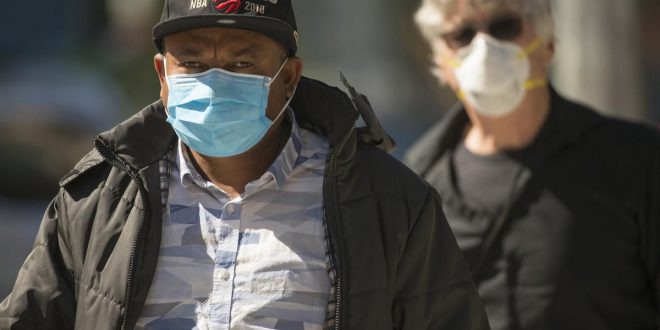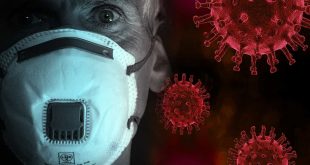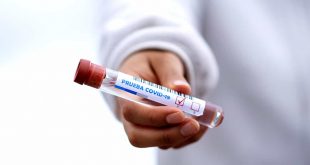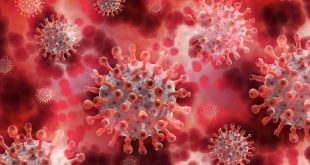The latest novel coronavirus news from Canada and around the world Thursday (this file will be updated throughout the day). Web links to longer stories if available.
7:24 a.m. Republican political operatives are recruiting “extremely pro-Trump” doctors to go on television to prescribe reviving the U.S. economy as quickly as possible, without waiting to meet safety benchmarks proposed by the federal Centers for Disease Control and Prevention to slow the spread of the new coronavirus.
The plan was discussed in a May 11 conference call with a senior staffer for the Trump reelection campaign organized by CNP Action, an affiliate of the GOP-aligned Council for National Policy. A leaked recording of the hourlong call was provided to The Associated Press by the Center for Media and Democracy, a progressive watchdog group.
CNP Action is part of the Save Our Country Coalition, an alliance of conservative think tanks and political committees formed in late April to end state lockdowns implemented in response to the pandemic. Other members of the coalition include the FreedomWorks Foundation, the American Legislative Exchange Council and Tea Party Patriots.
A resurgent economy is seen as critical to boosting President Donald Trump’s reelection hopes and has become a growing focus of the White House coronavirus task force led by Vice-President Mike Pence.
Tim Murtaugh, the Trump campaign communications director, confirmed to AP that an effort to recruit doctors to publicly support the president is underway, but declined to say when the initiative would be rolled out.
7:11 a.m. Oxfam International, one of the world’s leading aid agencies, is to severely curtail its work because of the financial strain caused by the coronavirus pandemic, including the closure of operations in 18 countries at the potential cost of more than 2,000 jobs.
The organization, which currently operates in 66 countries and whose global work is co-ordinated via 20 affiliate offices around the world, said in a statement late Wednesday that it has had to accelerate changes as a result of the pandemic.
Countries it will be exiting include Afghanistan, Egypt, Rwanda, Sudan and Tanzania. It said the changes will affect around 1,450 out of nearly 5,000 program staff and 700 out of nearly 1,900 partner organizations.
Following the changes, it will retain a physical presence in 48 countries, six of which it will explore as new independent affiliate members, including Indonesia and Kenya.
7:11 a.m. The coronavirus has infected more than 10,000 health care workers in hard-hit Iran, news outlets reported Thursday.
The report carried by semiofficial news agencies, including ISNA, cited Deputy Health Minister Qassem Janbabaei, who did not elaborate. However, reports earlier in the week put the number of infected health care workers at only 800. Iran says more than 100 of those workers have died.
Iran on Thursday put the number of dead from the virus at 7,249, or 66 more than Wednesday. Health Ministry spokesman Kianoush Jahanpour said there were more than 129,000 confirmed cases of the virus, including 2,392 more than Wednesday.
Iran has the highest number of casualties from the disease in the region.
4:01 a.m.: The federal government is to provide more financial support to help off-reserve Indigenous People weather the COVID-19 pandemic.
The additional funding expected today comes amid criticism that the Trudeau government has largely ignored the plight of thousands of Indigenous people who live off-reserve and in urban centres.
Many of them were already among Canada’s most vulnerable before the pandemic hit in mid-March — struggling with poverty, homelessness, food insecurity and mental health and addiction issues.
The Congress of Aboriginal People, which represents some 90,000 off-reserve and non-status Indigenous people, has gone to court over what it says is the “inadequate and discriminatory” funding it has received compared to other Indigenous groups.
In mid-March, the government created the $305-million Indigenous Community Support Fund, most of which went to organizations representing First Nations, Inuit and Métis communities to help them prepare for and cope with the pandemic.
Only $15 million of that was allotted for off-reserve organizations, even though they serve more than half of Canada’s Indigenous population, and of that, CAP, which is seeking $16 million, received just $250,000.
“The amount CAP has received for our constituents across Canada is a slap in the face,” the group’s national chief, Robert Bertrand, told a Commons committee last week.
The additional funding Prime Minister Justin Trudeau is to announce today is expected to go to organizations that serve the off-reserve Indigenous population, such as the National Association of Friendship Centres.
The association says it has been delivering food, dealing with increased domestic violence, caring for elders and helping off-reserve Indigenous people find safe shelter and transportation and apply for emergency aid benefits, despite little financial help from Ottawa.
4:01 a.m.: Face masks are dangerous to the health of some Canadians and problematic for some others.
In recommending people wear masks in public to prevent the spread of COVID-19, national chief public health officer Theresa Tam has also warned against judging those who can’t wear them.
“Be very aware of those with different types of cognitive, intellectual disabilities, those who are hearing impaired and others,” Dr. Tam said.
“Don’t assume that someone who isn’t wearing a mask or is wearing something different doesn’t have an actual reason for it.”
Asthma Canada president and CEO Vanessa Foran said simply wearing a mask could create risk of an asthma attack.
She said if a mask inhibits the ability of someone to breathe in any way, they recommend not wearing one.
Foran suggests asthmatics wear a mask in their home for 20 minutes to test their comfort level before venturing out, and also to head out in cooler weather.
“Wearing masks means breathing hot and humid air, so that can trigger asthma symptoms,” she said.
“We say if they cannot wear a mask, they must ensure they’re maintaining physical distancing and practising good hand hygiene.”
4:01 a.m.: Provinces have been releasing plans for easing restrictions that were put in place to limit the spread of COVID-19.
Here is what some of the provinces have announced so far:
Newfoundland and Labrador
Newfoundland and Labrador lifted some of the public health restrictions imposed to slow the spread of COVID-19 on May 11.
The province has entered “alert level four” in its five-level reopening plan, allowing some businesses such as law firms and other professional services to reopen along with regulated child-care centres, with some restrictions.
Small gatherings for funerals, burials and weddings are also permitted with a limit of 10 people following physical distancing rules.
Municipal parks, golf courses and driving ranges can open and recreational hunting and fishing are permitted. Officials are reminding people that the new rules do not allow for parties or other social gatherings.
The province is loosening restrictions in a series of “alert levels” descending from five. The current alert level is to remain in place for at least 28 days.
At Level 3, private health clinics, such as optometrists and dentists, are to be permitted to open, as well as medium-risk businesses such as clothing stores and hair salons.
At Level 2, some small gatherings will be allowed, and businesses with performance spaces and gyms are to reopen.
Level 1 would represent “the new normal.”
Nova Scotia
Nova Scotia Premier Stephen McNeil has announced there will be no return to school this year. He also says a decision on whether daycares will reopen will be made by June 8. Nova Scotia has eased some public health restrictions, however, directives around physical distancing and social gatherings remain in place.
Trails and provincial and municipal parks can now reopen along with garden centres, nurseries and similar businesses, but playground equipment is still off limits.
Public beaches also reopened along with outdoor activities like archery, horseback riding, golf, paddling, boating and tennis, with the proviso that social distancing and hygiene be maintained.
Sport fishing is permitted and people can attend boating, yacht or sailing clubs for the purpose of preparing boats for use. Drive-in religious services are now allowed, if people stay in their cars, park two metres apart and there are no interactions between people.
The government announced the loosening of some restrictions and introduced a “family bubble” policy, allowing two immediate family households to come together without physical distancing.
The province is following federal health guidelines and the chief medical officer of health has stressed that the number of new COVID-19 cases caused by community transmission must drop to few or no cases for at least two weeks — ideally 28 days — before an economic recovery plan is implemented.
Prince Edward Island
P.E.I. is accelerating its Renew PEI Together plan. Phase two of the plan will still begin May 22 as scheduled, but the third phase will now begin June 1 instead of June 12.
Phase three will allow gatherings of up to 15 people indoors and 20 people outdoors, organized recreational activities and the opening of child-care centres and in-room dining. Members of a household can currently gather indoors with up to five other people.
Other precautions, such as physical distancing remain in place.
Screening also continues at points of entry into the province and all people coming into P.E.I. are required to isolate for 14 days. Priority non-urgent surgeries and select health-service providers, including physiotherapists, optometrists and chiropractors, resumed on May 1.
The Renew P.E.I. Together plan also allows outdoor gatherings and noncontact outdoor recreational activities of no more than five individuals from different households.
New Brunswick
New Brunswick’s education minister said licensed daycares can begin reopening May 19. Children won’t have to wear masks or maintain physical distancing, but they will be in small groups.
Anyone who has travelled outside of New Brunswick will not be allowed to visit early learning and child-care facilities for 14 days.
Meanwhile, the province has allowed more businesses and services to reopen.
Retail businesses, offices, restaurants, libraries, museums and seasonal campgrounds can do so under certain conditions. Those include having an operational plan that explains how they are meeting public health guidelines including physical distancing, hand hygiene and allowing staff to remain home when ill.
Outdoor gatherings of up to 10 people are also allowed if physical distancing is respected.
The resumption of elective surgeries is also part of the province’s phase two of its reopening plan.
The third phase will allow regular church services, dentistry work and the reopening of fitness centres.
The final phase, which will probably come only after a vaccine is available, will include large gatherings.
Phase one, which started on April 24, allowed limited play on golf courses as well as fishing and hunting.
Post-secondary students were allowed to return if it was deemed safe by the school, and outdoor church services were again permitted, providing people remain in their vehicles and are two metres apart.
Quebec
Quebec reopened retail stores outside Montreal on May 11.
Lottery terminals are also reopening after being shut down on March 20 with sales moving to online only.
Quebec’s construction and manufacturing industries have resumed operations with limits on the number of employees who can work per shift. Elementary schools and daycares outside Montreal reopened on May 11, but high schools, junior colleges and universities will stay closed until September.
Elementary schools in the greater Montreal area will remain closed until late August.
Premier François Legault says public health conditions haven’t been met in the area hardest hit by the coronavirus, so Montreal daycares will also remain closed until at least June 1.
Officials haven’t made a firm decision about retail businesses, which are scheduled to reopen May 25.
Meanwhile, checkpoints set up to slow the spread of COVID-19 came down on May 18 in various parts of Quebec, including between Gatineau and Ottawa.
Ontario
Ontario began its first stage of reopening May 19 including lifting restrictions on retail stores and surgeries.
The province says workplaces can begin to reopen but working from home should continue as much as possible.
All construction can resume, and limits will be lifted on maintenance, repair and property management services, such as cleaning, painting and pool maintenance.
Most retail stores that have a street entrance can reopen with physical distancing restrictions, such as limits on the number of customers in a store and providing curbside pickup and delivery.
Golf courses can reopen though clubhouses can only open for washrooms and takeout food. Marinas, boat clubs and public boat launches can also open, as can private parks and campgrounds for trailers and RVs whose owners have a full season contract, and businesses that board animals.
Other businesses and services included in the stage one reopening include regular veterinary appointments, pet grooming, pet sitting and pet training; libraries for pickup or deliveries; and housekeepers and babysitters.
Get the latest in your inbox
Never miss the latest news from the Star, including up-to-date coronavirus coverage, with our email newsletters
Premier Doug Ford announced that Ontario schools will stay closed for the rest of the school year.
Saskatchewan
The Saskatchewan government’s five-phase plan to reopen its economy started May 11 with dentists, optometrists and other health professionals allowed to resume services. Phase 1 also includes reopened golf courses and campgrounds.
Phase 2 will give the green light to retail businesses and salons.
Restaurants and gyms could open in Phase 3, but with limited capacity.
Phase 4 could see arenas, swimming pools and playgrounds opening.
In Phase 5, the province would consider lifting restrictions on the size of public gatherings.
Manitoba
The Manitoba government has lifted its one-month limit on people’s prescription drug supplies, allowing people to again get prescriptions filled or refilled for 90 days.
Its health offices, including dentists, chiropractors and physiotherapists can also reopen. Retail businesses can reopen at half occupancy providing they ensure physical spacing.
Restaurants can reopen patios and walk-up service.
Museums and libraries can also reopen, but with occupancy limited to 50 per cent.
Playgrounds, golf courses and tennis courts reopened as well, along with parks and campgrounds.
Starting Friday, the province will allow groups of up to 25 people indoors and 50 people outdoors.
The province also plans to ease a ban on people visiting loved ones in personal care homes. By the end of next week, homes will be allowed to offer limited, outdoor visits with a maximum of two guests per resident.
Visitors will be screened on their arrival and will have to continue to practice physical distancing.
A second phase is to begin no earlier than June 1. That’s when restaurants would be allowed to open indoor dining areas and noncontact children’s sports would resume.
Mass gatherings such as concerts and major sporting events will not be considered before September. Meanwhile, Manitoba has extended a province-wide state of emergency until mid-June, to help prevent the spread of COVID-19.
Alberta
Alberta has increased the limit for outdoor gatherings to 50 people — up from 15.
The province allowed stores, restaurants, daycares and hair salons to reopen across much of the province on May 14. But hair salons and restaurant dining rooms can’t reopen in Calgary and Brooks until May 25.
Restaurants can only open at half capacity.
Premier Jason Kenney says if the first stage of reopening goes well, the next phase — which includes movie theatres and spas — could go ahead on June 19.
Alberta allowed some scheduled, non-urgent surgeries to start on May 11.
Service provided by dentists, physiotherapists and other medical professionals are also permitted. Golf courses reopened May 2, though pro shops and clubhouses remain shuttered.
British Columbia
The provincial government allowed a partial reopening of the B.C. economy starting May 19.
The reopening plans are contingent on organizations and businesses having plans that follow provincial guidelines to control the spread of COVID-19. Hotels, resorts and parks will follow in June.
Parents in B.C. will be given the choice of allowing their children to return to class on a part-time basis in June. The government says its goal is for the return of full-time classes in September, if it’s safe.
Under the part-time plan, for kindergarten to Grade 5, most students will go to school half time, while grades 6 to 12 will go about one day a week. A mix of online and classroom post-secondary education is planned for September.
Conventions, large concerts, international tourism and professional sports with a live audience will not be allowed to resume until either a vaccine is widely available, community immunity has been reached, or effective treatment can be provided for the disease.
Northwest Territories
The Northwest Territories announced on May 12 a reopening plan that contains three phases, but the government didn’t say when it would be implemented.
The plan includes more gatherings and the possible reopening of some schools and businesses. However, the territory’s borders remain closed indefinitely to non-residents and non-essential workers.
There are several requirements that must be met before any measures are relaxed: there must be no evidence of community spread until today; travel entry points in the territory are strong and secure; risks are reduced from workers coming into the territory; and expanded community testing is available.
Yukon
The territory’s reopening plan outlines five phases including a period after a vaccine is available.
The plan’s “restart” phase began May 15, with businesses that were ordered to close allowed to reopen as long as they submit an operational plan.
Two households of up to 10 people in total are also able to interact with each other as part of a “household bubble.”
But bars and restaurants that offer dine-in services won’t be allowed to reopen until the chief medical officer of health lifts restrictions.
The territory’s borders also remain closed but residents are allowed to travel throughout Yukon more easily.
12:08 a.m.: Strong concern about a second wave of coronavirus infections in the U.S. is reinforcing widespread opposition among Americans to reopening public places, a new poll finds, even as many state leaders step up efforts to return to life before the pandemic.
Yet support for public health restrictions imposed to control the virus’s spread is no longer overwhelming. It has been eroded over the past month by a widening partisan divide, with Democrats more cautious and Republicans less anxious as President Donald Trump urges states to “open up our country,” according to the new survey from The Associated Press-NORC Center for Public Affairs Research.
The poll finds that 83 per cent of Americans are at least somewhat concerned that lifting restrictions in their area will lead to additional infections, with 54 per cent saying they are very or extremely concerned that such steps will result in a spike of COVID-19 cases.
Wednesday 7:41 p.m.: A staff member at the Peter D. Clark long-term-care home in Ottawa has died of COVID-19.
“My sincere condolences to their family, friends, and colleagues,” Mayor Jim Watson wrote on Twitter. “I want to thank all our front-line staff for their continued efforts to keep some of the most vulnerable residents safe and healthy during these challenging times.”
The name of the employee was not released by the city.
A second resident at the city-run home was reported to have died from COVID-19 on Monday. Fourteen employees and 19 residents that have tested positive for the virus.
Wednesday 5:41 p.m.: Ontario’s regional health units are now reporting more than 25,000 COVID-19 cases following a second consecutive day of case totals that suggest a recent declining trend may be reversing, according to the Star’s latest count.
As of 5 p.m. Wednesday, the health units had reported a total of 25,364 confirmed and probable cases, including 2,065 deaths.
The total of 435 new confirmed and probable cases reported since the same time Tuesday evening was down more than 100 from the previous day’s total, but still up considerably from recent averages.
The number of new cases reported each day had been on a downward trend since hitting a peak of more than 700 in late April. However, the trend in the daily average has begun to rise again after flattening out to an average of about 360 cases per day last week.
The jump in cases reported Wednesday also included a large increase of 263 new cases in Toronto, the second consecutive day the city hit that total. Combined, the 526 cases reported in Toronto since Monday evening were the most in any 48-hour period since mid-April.
Meanwhile, the 47 fatalities reported in the province since Tuesday evening were also well above recent trends. Nevertheless, the death rate has fallen considerably since peaking at more than 90 deaths in a day earlier this month, about two weeks after the peak in the daily case totals.
Earlier Wednesday, the province once again reported the testing labs had completed far fewer tests than its target of 16,000 a day. In its daily data release, the province said the labs had completed just 7,382 tests the previous day, the second in a row after the long weekend to see very few tests completed.
Because many health units publish tallies to their websites before reporting to Public Health Ontario, the Star’s count is more current than the data the province puts out each morning.
The province also reported 991 patients are now hospitalized with COVID-19, including 160 in intensive care, of whom 120 are on a ventilator. The province also says more than 18,000 patients who have tested positive for the coronavirus have now recovered from the disease.
The province says its data is accurate to 4 p.m. the previous day. The province also cautions its latest count of total deaths — 1,962 — may be incomplete or out of date due to delays in the reporting system, saying that in the event of a discrepancy, data reported by the health units should be considered the most up to date.
The Star’s count includes some patients reported as “probable” COVID-19 cases, meaning they have symptoms and contacts or travel history that indicate they very likely have the disease, but have not yet received a positive result from a lab test.
 The Argus Report Read about it!
The Argus Report Read about it!





